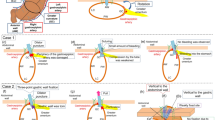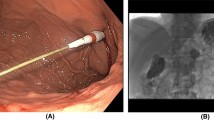Abstract
Background
The techniques of percutaneous endoscopic gastrostomy are classified as the pull and introducer methods. Peristomal infection is the most common procedure-related complication in the pull method.
Objectives
The objective of this study was to compare procedure-related complications between the two methods and to assess the outcome of long-term use of the introducer method.
Methods
Between January 1999 and November 2009, 116 patients received percutaneous endoscopic gastrostomy at Seoul St. Mary’s Hospital in Korea. Before June 2006, the pull method was used for all patients; since then, every patient had been treated using the introducer method. We compared outcomes and complications within 180 days of gastrostomy placement for the two methods.
Results
The pull method was performed on 63 patients and the introducer method on 53 patients. The occurrence of peristomal infection within 30 days was significantly lower in the introducer method group than in the pull method group (1.9% vs. 36.5%, P = 0.001). Methicillin-resistant Staphylococcus aureus, Pseudomonas aeruginosa, and Klebsiella pneumoniae were the major organisms isolated from the peristomal infection. The requirement for catheter reinsertion because of displacement, obstruction, or damage to the catheter between 30 and 180 days was significantly higher in the introducer method group than in the pull method group (40.5% vs. 0%, P = 0.001).
Conclusions
Our results suggest the superiority of the introducer method in terms of infection control. However, the balloon-type catheter is associated with problems such as balloon insufficiency in long-term use.
Similar content being viewed by others
References
Gauderer MW, Ponsky JL, Izant RJ Jr. Gastrostomy without laparotomy: a percutaneous endoscopic technique. J Pediatr Surg. 1980;15:872–875.
Jain NK, Larson DE, Schroeder KW, et al. Antibiotic prophylaxis for percutaneous endoscopic gastrostomy. A prospective, randomized, double-blind clinical trial. Ann Intern Med. 1987;107:824–828.
Jonas SK, Neimark S, Panwalker AP. Effect of antibiotic prophylaxis in percutaneous endoscopic gastrostomy. Am J Gastroenterol. 1985;80:438–441.
Schapiro GD, Edmundowicz SA. Complications of percutaneous endoscopic gastrostomy. Gastrointest Endosc Clin N Am. 1996;6:409–422.
McClave SA, Chang WK. Complications of enteral access. Gastrointest Endosc. 2003;58:739–751.
Sharma VK, Howden CW. Meta-analysis of randomized, controlled trials of antibiotic prophylaxis before percutaneous endoscopic gastrostomy. Am J Gastroenterol. 2000;95:3133–3136.
Rey JR, Axon A, Budzynska A, Kruse A, Nowak A. Guidelines of the European Society of Gastrointestinal Endoscopy (E.S.G.E.) antibiotic prophylaxis for gastrointestinal endoscopy. European Society of Gastrointestinal Endoscopy. Endoscopy. 1998;30:318–324.
American Society for Gastrointestinal Endoscopy. Infection control during gastrointestinal endoscopy: guidelines for clinical application. From the ASGE. Gastrointest Endosc. 1999;49:836–841.
Horiuchi A, Nakayama Y, Tanaka N, Fujii H, Kajiyama M. Prospective randomized trial comparing the direct method using a 24 Fr bumper-button-type device with the pull method for percutaneous endoscopic gastrostomy. Endoscopy. 2008;40:722–726.
Maetani I, Tada T, Ukita T, Inoue H, Sakai Y, Yoshikawa M. PEG with introducer or pull method: a prospective randomized comparison. Gastrointest Endosc. 2003;57:837–841.
You CR, Kim SW, Paik CN, et al. A risk factor for wound infection after percutaneous endoscopic gastrostomy: decreased performance status. Korean J Gastrointest Endosc. 2007;35:133–139.
Horiuchi A, Nakayama Y, Kajiyama M, Fujii H, Tanaka N. Nasopharyngeal decolonization of methicillin-resistant Staphylococcus aureus can reduce peristomal wound infection. Am J Gastroenterol. 2006;101:274–277.
Pien EC, Hume KE, Pien FD. Gastrostomy tube infections in a community hospital. Am J Infect Control. 1996;24:353–358.
Nunley D, Berk SL. Percutaneous endoscopic gastrostomy as an unrecognized source of methicillin-resistant Staphylococcus aureus colonization. Am J Gastroenterol. 1992;87:58–61.
Chaudhary KA, Smith OJ, Cuddy PG, Clarkston WK. PEG site infections: the emergence of methicillin-resistant Staphylococcus aureus as a major pathogen. Am J Gastroenterol. 2002;97:1713–1716.
Hull M, Beane A, Bowen J, Settle C. Methicillin-resistant Staphylococcus aureus infection of percutaneous endoscopic gastrostomy sites. Aliment Pharmacol Ther. 2001;15:1883–1888.
Faias S, Cravo M, Claro I, Lage P, Nobre-Leitão C. High rate of percutaneous endoscopic gastrostomy site infections due to oropharyngeal colonization. Dig Dis Sci. 2006;51:2384–2388.
Thomas S, Cantrill S, Waghorn DJ, McIntyre A. The role of screening and antibiotic prophylaxis in the prevention of percutaneous gastrostomy site infection caused by methicillin-resistant Staphylococcus aureus. Aliment Pharmacol Ther. 2007;25:593–597.
Russell TR, Brotman M, Norris F. Percutaneous gastrostomy. A new simplified and cost-effective technique. Am J Surg. 1984;148:132–137.
Deitel M, Bendago M, Spratt EH, Burul CJ, To TB. Percutaneous endoscopic gastrostomy by the “pull” and “introducer” methods. Can J Surg. 1988;31:102–104.
Toyama Y, Usuba T, Son K, et al. Successful new method of extracorporeal percutaneous endoscopic gastrostomy (E-PEG). Surg Endosc. 2007;21:2034–2038.
Hiki N, Maetani I, Suzuki Y, et al. Reduced risk of peristomal infection of direct percutaneous endoscopic gastrostomy in cancer patients: comparison with the pull percutaneous endoscopic gastrostomy procedure. J Am Coll Surg. 2008;207:737–744.
Shastri YM, Hoepffner N, Tessmer A, Ackermann H, Schroeder O, Stein J. New introducer PEG gastropexy does not require prophylactic antibiotics: multicenter prospective randomized double-blind placebo-controlled study. Gastrointest Endosc. 2008;67:620–628.
Higaki F, Yokota O, Ohishi M. Factors predictive of survival after percutaneous endoscopic gastrostomy in the elderly: is dementia really a risk factor? Am J Gastroenterol. 2008;103:1011–1016.
Tominaga N, Shimoda R, Iwakiri R, et al. Low serum albumin level is risk factor for patients with percutaneous endoscopic gastrostomy. Intern Med. 2010;49:2283–2288.
Competing interests
Drs. Lim, Park, Cho, Lee, Kim, Choi, and Chung have no conflicts of interest or financial ties to disclose.
Author information
Authors and Affiliations
Corresponding author
Rights and permissions
About this article
Cite this article
Lim, CH., Park, J.M., Cho, Y.K. et al. Successful Control of Peristomal Infection by Introducer-Type Percutaneous Endoscopic Gastrostomy: A Retrospective Historical Control Study. Dig Dis Sci 56, 2024–2029 (2011). https://doi.org/10.1007/s10620-011-1570-9
Received:
Accepted:
Published:
Issue Date:
DOI: https://doi.org/10.1007/s10620-011-1570-9




